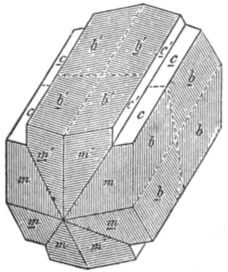1911 Encyclopædia Britannica/Harmotome
 |
HARMOTOME, a mineral of the zeolite group, consisting of hydrous barium and aluminium silicate, H2BaAl2(SiO3)5 + 5H2O. Usually a small amount of potassium is present replacing part of the barium. The system of crystallization is monoclinic; only complex twinned crystals are known. A common and characteristic form of twinned crystal, such as is represented in the figure, consists of four intercrossing individuals twinned together according to two twin-laws; the compound group resembles a tetragonal crystal with prism and pyramid, but may be distinguished from this by the grooves along the edges of the pseudo-prism. The faces of the crystals are marked by characteristic striations, as indicated in the figure. Twinned crystals of exactly the same kind are also frequent in phillipsite (q.v.). Crystals are usually white and translucent, with a vitreous lustre. The hardness is 41/2, and the specific gravity 2.5.
The name harmotome (from ἁρμός, “a joint,” and τέμνειν, “to cut”) was given by R. J. Haüy in 1801, and has a crystallographic signification. Earlier names are cross-stone (Ger. Kreuzstein), ercinite, andreasbergolite and andreolite, the two last being derived from the locality, Andreasberg in the Harz. Morvenite (from Morven in Argyllshire) is the name given to small transparent crystals formerly referred to as phillipsite.
Like other zeolites, harmotome occurs with calcite in the amygdaloidal cavities of volcanic rocks, for example, in the dolerites of Dumbartonshire, and as fine crystals in the agate-lined cavities in the melaphyre of Oberstein in Germany. It also occurs in gneiss, and sometimes in metalliferous veins. At Andreasberg in the Harz it is found in the lead and silver veins; and at Strontian in Argyllshire in lead veins, associated with brewsterite (a strontium and barium zeolite), barytes and calcite. (L. J. S.)
